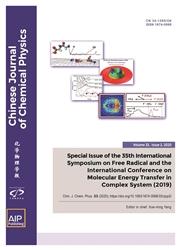三种典型抗生素与氧化石墨烯/壳聚糖复合材料的界面机制:实验和理论研究
IF 1.2
4区 化学
Q4 PHYSICS, ATOMIC, MOLECULAR & CHEMICAL
引用次数: 0
摘要
抗生素的广泛应用给人类健康和环境带来了一系列负面影响,引起了人们对其从水系统中去除的广泛关注。本研究采用改进的hummers/溶剂热法合成了壳聚糖(CS)-氧化石墨烯(GO-CS)复合材料。通过低速离心将其从混合水相中分离出来,使氧化石墨烯在水中具有较高的分离效率。通过实验技术和理论计算研究了GO-CS对四环素(TC)、诺氟沙星(NOR)和磺胺嘧啶(SDZ)的吸附。在298 K和最佳pH条件下的批量实验中,TC、NOR和SDZ的吸附量分别为597.77、388.99和136.37 mg/g,远远优于原始氧化石墨烯。光谱结果表明,抗生素与GO-CS的羧基、羟基、氨基等官能团的相互作用是其吸附过程的主要原因。此外,密度泛函理论计算表明,静电相互作用和氢键对抗生素的吸收至关重要;前者对TC的吸附极为重要。本研究为石墨烯基复合材料去除抗生素提供了理论参考,为其在环境修复中的应用提供了前景。本文章由计算机程序翻译,如有差异,请以英文原文为准。
Insights into interface mechanism of three typical antibiotics onto the graphene oxide/chitosan composite: Experimental and theoretical investigation
The general application of antibiotics has brought a series of negative impacts on human health and the environment, which has aroused widespread public attention to their removal from aqueous systems. In this study, a chitosan (CS)-linked graphene oxide (GO) composite (GO-CS) was synthesized by a modified hummers/solvothermal method. It was separated from the mixed aqueous phase by low-speed centrifugation, thereby endowing the GO with high separation efficiency in water. The adsorption of tetracycline (TC), norfloxacin (NOR), and sulfadiazine (SDZ) by GO-CS were then studied by experimental techniques and theoretical calculations. In batch experiments at 298 K and optimal pH, the adsorption capacities of TC, NOR, and SDZ were 597.77, 388.99, and 136.37 mg/g, respectively, which were far better than those of pristine graphene oxide. The spectra results illustrated that the adsorption process was mainly contributed by the interactions between antibiotics and functional groups (carboxyl, hydroxyl, and amino groups) of GO-CS. Furthermore, density functional theory calculations showed that electrostatic interaction and hydrogen bonds were of vital importance for the uptake of the antibiotics; the former was extremely important for TC adsorption. This research provides theoretical references for the removal of antibiotics by graphene-based composite materials, thus offering their promising application in environmental remediation.
求助全文
通过发布文献求助,成功后即可免费获取论文全文。
去求助
来源期刊

Chinese Journal of Chemical Physics
物理-物理:原子、分子和化学物理
CiteScore
1.90
自引率
10.00%
发文量
2763
审稿时长
3 months
期刊介绍:
Chinese Journal of Chemical Physics (CJCP) aims to bridge atomic and molecular level research in broad scope for disciplines in chemistry, physics, material science and life sciences, including the following:
Theoretical Methods, Algorithms, Statistical and Quantum Chemistry
Gas Phase Dynamics and Structure: Spectroscopy, Molecular Interactions, Scattering, Photochemistry
Condensed Phase Dynamics, Structure, and Thermodynamics: Spectroscopy, Reactions, and Relaxation Processes
Surfaces, Interfaces, Single Molecules, Materials and Nanosciences
Polymers, Biopolymers, and Complex Systems
Other related topics
 求助内容:
求助内容: 应助结果提醒方式:
应助结果提醒方式:


